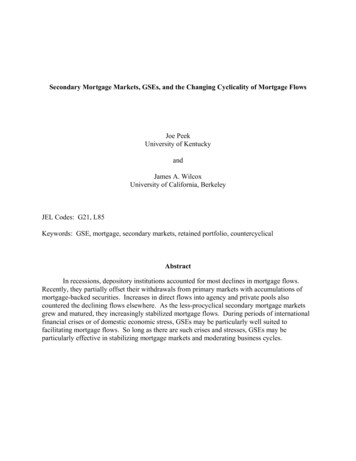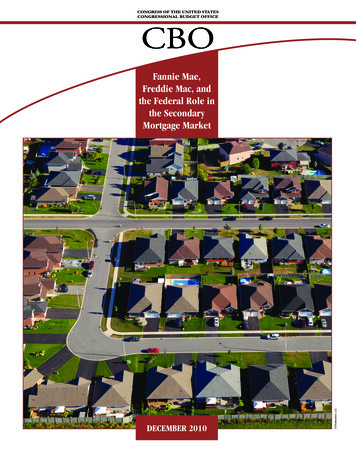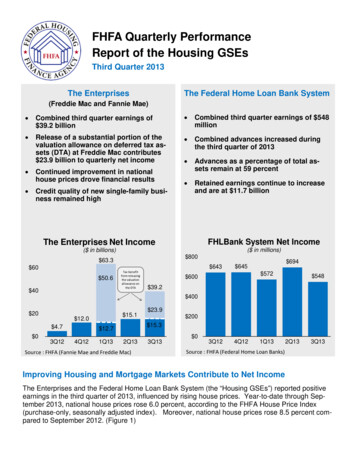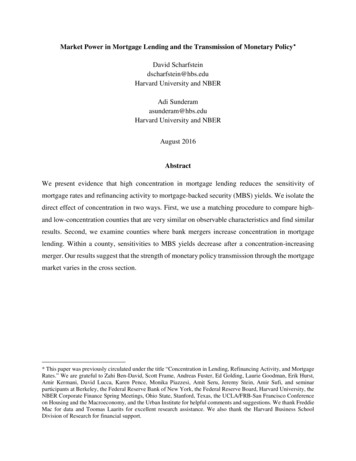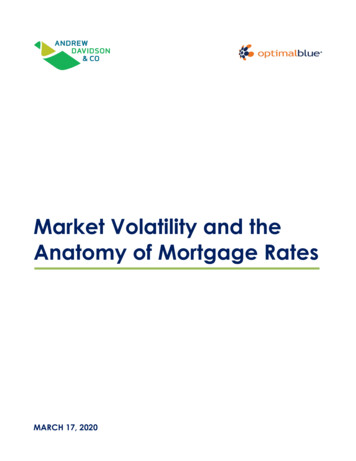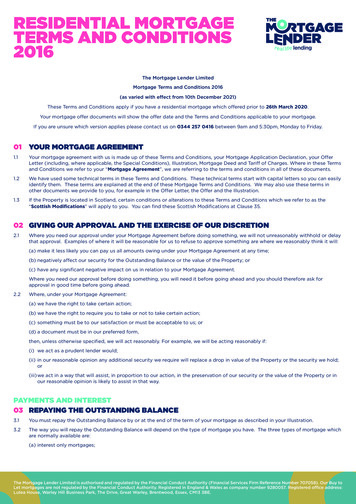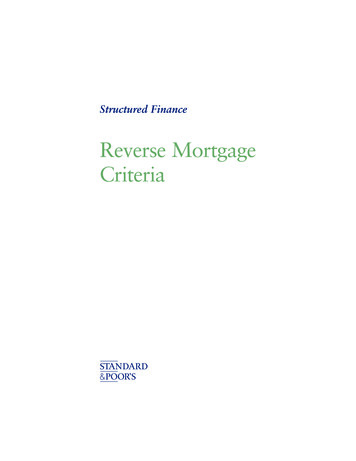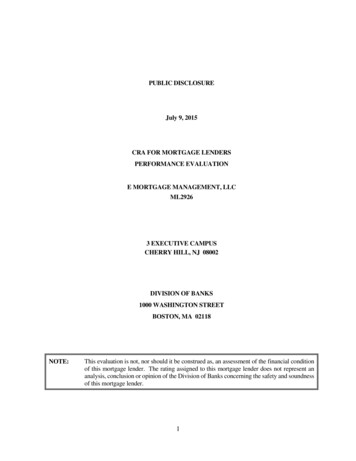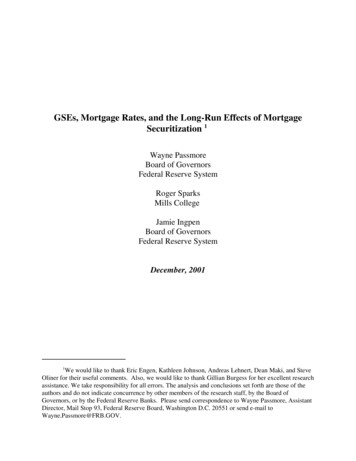
Transcription
GSEs, Mortgage Rates, and the Long-Run Effects of MortgageSecuritization 1Wayne PassmoreBoard of GovernorsFederal Reserve SystemRoger SparksMills CollegeJamie IngpenBoard of GovernorsFederal Reserve SystemDecember, 20011We would like to thank Eric Engen, Kathleen Johnson, Andreas Lehnert, Dean Maki, and SteveOliner for their useful comments. Also, we would like to thank Gillian Burgess for her excellent researchassistance. We take responsibility for all errors. The analysis and conclusions set forth are those of theauthors and do not indicate concurrence by other members of the research staff, by the Board ofGovernors, or by the Federal Reserve Banks. Please send correspondence to Wayne Passmore, AssistantDirector, Mail Stop 93, Federal Reserve Board, Washington D.C. 20551 or send e-mail toWayne.Passmore@FRB.GOV.
GSEs, Mortgage Rates, and the Long-Run Effects of MortgageSecuritizationAbstractOur paper compares mortgage securitization undertaken by government-sponsored enterprises(GSEs) with that undertaken by private firms, with an emphasis on how each type of mortgagesecuritization affects mortgage rates. We build a model illustrating that market structure,government sponsorship, and the characteristics of the mortgages securitized are all importantdeterminants of mortgage rates. We find that GSEs generally–but not always—lower mortgagerates, particularly when the GSEs behave competitively, because the GSEs’ implicit governmentbacking allows them to sell securities without the credit enhancements needed in the privatesector. Using our simulation model, we demonstrate that when mortgages eligible for purchaseby the GSEs have characteristics similar to other mortgages, the GSEs’ implicit governmentbacking generates differences in mortgage rates similar to those currently observed in themortgage market (which range between zero and fifty basis points). However, if the mortgagespurchased by GSEs are less costly to originate and securitize, and the if the GSEs behavecompetitively, then the simulated spread in mortgage rates can be much larger than that observedin the data.
IntroductionThe mortgage-backed securities market in the United States is dominated by twoprivately-owned but government-sponsored institutions--the Federal National MortgageAssociation (Fannie Mae) and the Federal Home Loan Mortgage Corporation (FreddieMac)—and includes a variety of smaller, fully private firms that securitize the remainingmortgages, which are not eligible for securitization by Fannie Mae or Freddie Mac. Theoutstanding stock of mortgages securitized and made available to investors by Fannie Mae andFreddie Mac totaled more than 1.2 trillion at the end of 2000, roughly four times the amountsecuritized by the fully private part of the market.2Investors generally perceive Fannie Mae and Freddie Mac as having the implicitbacking of the U.S. government, which allows these government-sponsored enterprises (GSEs)to issue debt at lower interest rates than they could otherwise and to securitize mortgageswithout providing or purchasing credit enhancements. This implicit subsidy benefits FannieMae and Freddie Mac’s shareholders, though part of the subsidy may flow through to theprimary mortgage market.3At first blush, one might wonder why any of the subsidy would pass through tohomeowners, particularly since in competitive markets, if only two producers among manyreceive a subsidy, then those two subsidized producers simply have increased profits and thereis no effect on prices for the product.4 Goodman and Passmore (1992) and Hermalin and2Fannie and Freddie also directly held about 1.0 trillion of mortgages and mortgage-backedsecurities at year-end 2000. During the 1990s, their yearly securitization rate is estimated to havefluctuated between 45 percent and 78 percent of conventional conforming mortgage originations.Information about Fannie’s and Freddie’s holdings is from their quarterly and annual reports, whereasinformation about the fully private market is from Inside MBS & ABS, February 2, 2000, page 7. Thesecuritization rate is from Inside Mortgage Finance Publications (2000).3For a review of efforts to measure the size of the GSE subsidy, see Feldman (1999). For anexposition of how the GSE subsidy benefits shareholders and others, see Congressional Budget Office(1996, 2001) and General Accounting Office (1996).4Note that Fannie and Freddie—like all insurers of credit risk—face an adverse selectionproblem that requires they include a “lemons premium” in the purchase price they offer for mortgages.Theoretically, their subsidy could be completely absorbed by the GSEs’ efforts to avoid adverse selection(Passmore and Sparks, 1996 & 2000).1
Jaffee (1996) argue that the subsidy may be partly transmitted because the secondary markethas many of the conditions required for collusion—two rivals with roughly equal market shareand almost infinite production capacity, homogeneity of product, and high entry and exitbarriers—and thus these two firms are cognizant of the effects their prices have on demand.5Given these conditions, if Fannie Mae and Freddie Mac compete vigorously with each other(they are “Bertrand competitors”), then most of the GSE subsidy is likely to be passed on tomortgage borrowers. Evidence of a subsidy pass- through comes from three previous studies(Hendershott and Shilling, 1989; ICF, 1990; and Cotterman and Pearce, 1996), which foundthat interest rates for mortgages eligible for purchase by the GSEs are about 30 basis pointsless than mortgage rates for other mortgages.How does the GSEs’ implicit subsidy affect mortgage securitization, and under whatconditions does it lower mortgage rates? Unlike when GSEs buy and hold mortgages, and thusthen fund with implicitly guaranteed debt, when the GSEs issue mortgage-backed securities, theydo not fund the mortgages directly. Thus, the implicit subsidy on the GSEs’ debt cannot directlyaffect the yields on the mortgage-backed securities because debt is not used. With securitization,the mortgages are funded by the purchasers of the mortgage-backed securities. However, we findthat GSEs generally—but not always—cause mortgage rates to be lower in the long run than theywould be with private securitization because the GSEs have implicit public backing. WhenGSEs securitize mortgages, their implicit government backing allows them to sell securitieswithout holding the capital or purchasing the credit enhancements needed in the private sector.We use a simulation model to study the conditions under which implicit governmentbacking of mortgage-backed securities lowers mortgage rates, and we compare the simulatedspread between GSE and private mortgage rates to empirical spread to infer the underlyingmarket structure. Under the assumption that conforming mortgages (and their associatedmortgage-backed securities) are identical to nonconforming mortgages (and their associatedmortgage-backed securities), our simulations generally suggest that the observed difference inmortgage rates is greater than the simulated difference when Fannie and Freddie are modeled as5Neither study was able to establish definitely that Fannie and Freddie actually collude.2
monopolists and similar to the simulated difference when they are modeled as competitors.However, if GSE mortgage-backed securities are more liquid than non-GSE mortgage-backedsecurities, or if conforming mortgages are less expensive to originate or evaluate thannonconforming mortgages, then our simulations suggest the observed mortgage spread is lessthan would be realized if Fannie and Freddie behaved competitively. Our results highlight thedifficulty in analyzing the causes of the small differences between the GSE and non-GSEmortgage rates, suggesting that more information is needed before definitive conclusions can bedrawn about the effects of GSEs on mortgage rates.The GSEs and the Conforming Mortgage MarketFannie Mae and Freddie Mac were chartered many years ago as government-sponsoredenterprises, or GSEs, partly to correct perceived deficiencies in the mortgage market. (FannieMae converted to GSE status in 1968; Freddie Mac was chartered in 1970). In return for a GSEcharter, which is not made available to other firms that securitize mortgages, Fannie Mae andFreddie Mac shouldered a public mission: to develop a strong secondary market for mortgages byintegrating the mortgage markets with the capital markets and making funds more readilyavailable to mortgage borrowers. These objectives have been largely achieved, and the primaryremaining public function of these GSEs is to deliver a part of an implicit federal subsidy tomortgage borrowers. In addition to this function, the GSEs were mandated in 1992 by Congressto make a special effort to ensure that mortgages are provided to low- and moderate-incomehome buyers.The charters of Fannie Mae and Freddie Mac also restrict the types of mortgages theymay purchase. The restrictions include limiting the loan-to-value ratio to 80 percent or less(unless other measures are taken to limit the credit risk incurred by buying the mortgage) andlimiting the size of mortgages purchased. Loans that meet the GSEs’ charter restrictions areknown as conforming. The conforming loan limit for a mortgage backed by a single-familyresidence, which is adjusted annually, was 252,700 for mortgages originated in 2000. As willbe discussed below, the bulk of the nonconforming mortgages securitized by private firms arejumbo mortgages, or mortgages that exceed the GSE size limit.The most common procedure for securitizing mortgages involves a trade. In many cases,3
although not all, a large originator assembles a pool of conforming mortgages from its portfolioand trades the pool to the GSE in return for securities backed by the mortgages.6 In this process,lenders transfer the credit risk of the mortgages to the GSE. In return, the GSE receives aguarantee fee and a guaranteed cash flow from the mortgages (until the mortgage borrower paysoff or prepays the mortgage).The GSEs’ charters give them several competitive advantages over private firms whenissuing securities, including an exemption from SEC registration requirements and permission toclear GSE securities transactions through the Federal Reserve’s book-entry system. In addition,their securities are treated as government securities in the context of the Securities Exchange Actof 1934, which allows many trusts and other non-profit organizations to purchase them. Oneother notable, explicit advantage is that the risk-based capital requirements for banks’ holdings ofGSE-issued MBS are substantially lower than for their holdings of private MBS.The most valuable advantage to the GSEs, however, is the implicit U.S. governmentguarantee that backs GSE securities. Because these housing-related GSEs were initiallyestablished to carry out specific government policies and continue to have government missions,they have a special status in the eyes of many investors. The private market assumes that inalmost any adverse circumstances, the government will aid the GSEs; thus, Fannie Mae andFreddie Mac are able to issue debt at a lower cost. This implicit subsidy also gives them anadvantage in MBS issuance: the Congressional Budget Office (1996) estimated that an issuer’sGSE status lowers interest rates on MBS by 40 basis points from what a private firm would payon a comparable issue.Mortgage Securitization by Private FirmsThe presence of the GSEs effectively splits the primary mortgage market into threesegments: conforming, jumbo, and other nonconforming mortgages. The conforming marketconsists of mortgages that are generally low-risk and fall beneath the conforming loan size limit.6The GSEs were issuing mortgage-backed securities (MBS) in volume by the mid-1980s.4
The jumbo market is made up of loans that exceed the conforming loan size limit. Theremaining mortgages are non-jumbo and nonconforming: some of these may be high risk, such asmortgages with high loan-to-value ratios and no form of mortgage insurance, and some are lowrisk, such as loans with inadequate documentation but very low loan-to-value ratios. Mostprivate-sector securitizations are backed by jumbo mortgages or mortgages held by “sub-prime”borrowers, the bulk of which have blemished credit histories but adequate assets or income tosupport a mortgage.Lacking government backing, private securitizations usually use one of three methods tomitigate credit risk for the holders of the securities: a senior/subordinate structure,overcollateralization, or credit enhancement.7 In the first method, the cash flows from theunderlying mortgages are split into separate securities or tranches. These securities are usuallyordered by their relative riskiness, with the highest-rated tranche bearing little, if any, of theunderlying credit risk associated with the mortgages. At the other extreme, an unrated tranche,sometimes referred to as the “toxic waste,” is either retained by the originator or sold privately tounregulated purchasers such as hedge funds or private partnerships (or—during the 1980s—tosavings and loans). Between the almost riskless and riskiest security can lie many othersecurities, each with its own risk rating.Overcollateralization, where the originator backs the security with a stock of mortgageswhose value exceeds the face value of the security, is sometimes used in securitization.However, these days the technique is almost always combined with the senior/subordinatedstructure described above. Finally, credit enhancements for the securities, which protect theinvestors should the underlying assets default, can be purchased from banks, insurancecompanies, or even the GSEs.We now formally model this contrast between the GSE sector, where guarantees arecreated by the GSEs without an explicit cost imposed on the GSEs (but may present a contingentliability to taxpayers), and the private sector, where credit guarantees are costly for securitizers tocreate.7For a detailed overview of this market, see Bruskin, Sanders and Sykes (1999).5
Modeling Mortgage Securitization for Conforming LoansThe Bank and the Mortgage BorrowerIn our model, a mortgage is originated in the first period and securitized or not securitizedin the second period. In the third period, the homeowner either pays off the mortgage or defaultsand the bank’s balance sheet is “marked-to-market.” Both the mortgage originator andsecuritizer are risk neutral, and they know that the expected return from holding a mortgage is:(1)where r is the mortgage contract rate, q is the default probability, and rd is the return on adefaulted mortgage. We assume that these parameters are identical across mortgages.We assume the mortgage originator is a bank that has the option of holding the mortgagein its portfolio or swapping it for a mortgage-backed security issued by the mortgage securitizer.The principal and interest on the security are guaranteed by the securitizer. If the banksecurititizes the mortgage, it receives a benefit (denoted *) because the security is more easilytraded—in other words, is more liquid—than the mortgage.The cost of government-insured deposits is assumed to be less than the cost of equity, soour bank always funds with deposits if possible (which implies that banks hold the minimumamount of equity capital required by regulators). If the bank holds the mortgage, its weightedaverage cost of funding is:(2)where km is the regulatory minimum capital-to-asset ratio, rf is the yield on deposits, and re is theminimum expected return to capital. If the bank swaps the mortgage for a mortgage-backedsecurity, the cost of funds, denoted fmbs, is the same, with the exception that the minimum capitalratio becomes kmbs. Thus, if regulators view the mortgage-backed security as less risky than themortgage, the cost of funds is lower.Banking is assumed to be a perfectly competitive industry, in which economic profits arezero. We assume that each borrower’s mortgage costs the originator a different amount(denoted ki) to securitize. The cost of making a mortgage securitizable varies across borrowers,6
and is distributed uniformly over [0,"]. For example, some borrowers’ credit histories can bequickly discovered from computer databases, whereas uncovering other borrowers’ histories canbe quite time consuming. A bank may be willing to extend credit to a borrower in the lattergroup without the extensive documentation that would be required to securitize the mortgage.The bank chooses to securitize the mortgages of borrowers with smaller standardizationcosts, but not the mortgages of borrowers with higher standardization costs.8 In other words,the bank chooses a value for ki such that securitized mortgages have ki [0,p], where p is thecutoff value for ki that divides the population between securitized and non-securitized mortgages.The proportion of mortgages securitized is then p/".The bank’s profit function (its expected profit per mortgage originated) is written as:(3)where c is the total return on the mortgage security to the bank (which we will refer to as itseffective coupon, which is the stated coupon plus servicing income to the bank), t is the auditcost incurred by an outsider to the bank when determining the value of a mortgage held inportfolio (which the bank takes into account when considering the market value of its portfolio),* is the liquidity benefit derived from holding the mortgage as a security, and cm is the marginalcost of originating the mortgage.9 The average cost of securitizing mortgages is p/2.The bank chooses p to maximize profits. The first-order condition for this maximizationsets p equal to the difference between the return to holding the mortgage and the return to8In this paper, we ignore the possibility of adverse selection, where banks try to pass mortgagesto the securitizer that are expected to perform relatively worse, and the securitizer tries to defend itself.This possibility is discussed at length in Passmore and Sparks (1996, 1997). In addition, we ignore thepossibility of a corner solution because, while some individual institutions may securitize none or all oftheir mortgage originations, originators as a whole—as represented by our stylized originator—securitizesome mortgages and hold some mortgages.9The effective coupon or yield on a mortgage-backed security for the bank is determined by thecoupon, the guaranty fee charged by the securitizer, the servicing relationship between the originator andsecuritizer, and by other contractual features of the originator/securitizer relationship. For a review ofthe mechanics of mortgage-backed securitization, see Fabozzi (2001).7
holding the security, or 10:(4)Thus, equation 4 describes the originator’s behavioral response to the securitizer’s choice ofeffective coupon rate, to which our analysis now turns.The Mortgage SecuritizerThe mortgage securitizer chooses the effective coupon (c) to offer on the mortgagebacked security when it swaps the security for the mortgage. The securitizer guarantees thesecurity from credit losses and holds capital in a reserve to absorb potential losses (or,equivalently, “haircuts” the mortgages so that the dollar amount of securities issued is less thanthe dollar amount of mortgages held by the securitizer).The securitizer’s profit per originated mortgage is:(5)where ks is the securitizer’s regulatory minimum capital-to-asset ratio. In our model, capital iskept as a “reserve” against possible mortgage defaults and re - rf is the opportunity cost ofholding this capital. The securitizer chooses the effective coupon rate on the mortgage-backedsecurity to maximize profits, while knowing the bank’s optimal response in setting thesecuritization cutoff. Increasing c raises the securitizer’s costs, but induces the bank to securitizea higher proportion of mortgages (p* rises). The securitizer’s problem differs depending onwhether the securitizer operates in the conforming or nonconforming mortgage market.The Conforming Loan MarketAs discussed earlier, the mort
2 Fannie and Freddie also directly held about 1.0 trillion of mortgages and mortgage-backed securities at year-end 2000. During the 1990s, their yearly securitization rate is estimated to have fluctuated between 45 percent and 78 percent of conventional conforming mortgage originations.


